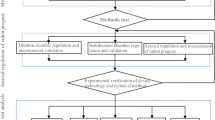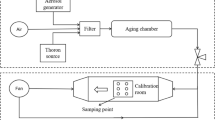Abstract
To calibrate radon progeny instruments and check the effectiveness of radon compensation for artificial radioactive aerosol instruments, a novel radon progeny generator was developed and its performance was tested in this study. The experimental results showed that equilibrium equivalent concentration could be controlled in the range of 1 × 102–1 × 104 Bq·m−3, the equilibrium factor could be controlled in the range of 0.14–0.48, and the unattached fraction of the radon progeny could be controlled in the range of 0.02–0.5. All of these characteristic parameters could be controlled stably and efficiently within 7 h.






Similar content being viewed by others
References
Porstendörfer J (1984) Behaviour of radon daughter products in indoor air. Radiat Prot Dosim 7(1–4):107–113
ICRU (2015) Measurement and reporting of radon exposures. ICRU 88 Reports Journal of the ICRU.
UNSCEAR (2000) UNSCEAR report 2000: sources and effects of ionizing radiation. United Nations Scientific Comittee on the Effects of Atomic Radiation.
Samuel BG, Sadou TS et al (2020) The importance of direct progeny measurements for correct estimation of effective dose due to radon and thoron. Front Public Health 8:1–12
Darby S, Hill D, Auvinen A et al (2005) Radon in homes and risk of lung cancer: collaborative analysis of individual data from 13 European case-control studies. BMJ 330:223. https://doi.org/10.1136/bmj.38308.477650.63
Nazir S, Simnani S, Mishra R, Sharma T, Masood S (2020) Simultaneous measurements of radon, thoron and their progeny for inhalation dose assessment in indoors of Srinagar, J&K. India J Radioanal Nucl Chem 325:315–328
Kumar M, Kumar P, Agrawal A et al (2020) Measurements of (222) Rn, Rn-220 and their progeny concentrations indoors around a coal/gas-based power plant and estimation of annual inhalation dose to the public. J Radioanal Nucl Chem 326(2):65–74
Gulan L, Milic G, Bossew P et al (2012) Field experience on indoor radon, thoron and their progenies with solid-state detectors in a survey of Kosovo and Metohija (Balkan Region). Radiat Prot Dosim 152(1–3):189–197
Jilek K, Thomas J, Brabec M (2008) Quality assurance programme for radon and its short-lived progeny measuring instruments in NRPI Prague. Radiat Prot Dosim 130(1):43–47
TRACERLAB GmbH, Quality and Technology TRACERLAB-Made in Germany. https://www.tracerlab.com. Accessed Jun 2014.
Yanyang L, Bin S, Qingzhi Z et al (2012) Comparison measurement methods and instruments of 222Rn/220Rn progeny. Radiat Protect 32(1):53–59 (in Chinese)
Liangjun L, Detao X, Jiarong L et al (2007) Development of radon progeny continuous measuring instrument. Atom Energy Sci Technol 41(4):509–512 (in Chinese)
Jihui Z, Yunyun W, Hongxing C, Qingzhao Z, Bing S (2010) Measurement and evaluation of EQF3120 radon/radon progeny monitor. Chin Prev Med 11(2):198–199 (in Chinese)
Nazaroff W (1983) Radon daughter carousel: an automated instrument for measuring indoor concentrations of 218Po, 214Pb and 214Bi. Rev Sci Instrum 54(9):1227–1233
International Electrotechnical Commission (1997) Radiation protection instrumentation -Calibration and verification of the effectiveness of radon compensation for alpha and beta aerosol measuring instruments—Test methods. IEC 61578 Ed. 1 Identical
JunCheng L, Penghui Z, Zhijie Y (2015) Development of calibration facility for radon and its progenies at NIM. Radiat Prot Dosim 167(1–3):82–86
Zettwoog P (1990) ICARE radon calibration device. J Res Natl Inst Stan 95(2):147–153
Hoover MD, Newton GJ (1998) Performance testing of continuous air monitors for alpha-emitting radionuclides. Radiat Prot Dosim 79(1):499–504
Antipin NI, Borunova EP, Vasin VA (1980) Special state standard for the volumetric activity of radioactive aerosols. Meas Tech 23(1):1–5
Hamel P, Schmidt V (2001) The calibration laboratories for the measurement of radon and short-lived radon decay products at the Federal Office for Radiation Protection (BfS). Clin Physiol 18(3):286–287
Jacobi W (1972) Activity and potential α-energy of 222Rn and 220Rn-daughters in different air atmospheres. Health Phys 22:441–450
Tabatabai MA (1988) Radon and its decay products in indoor air. J Environ Qual 18(1):132
Porstendörfer J, Reineking A (1992) Indoor behaviour and characteristics of radon progeny. Radiat Prot Dosim 45(1/4):303–311
Mohery M, EI-Hussein A, Alddin S H, et, al, (2012) Unattached fractions and aerosol attached of radon progeny in indoor air. Int J Phys Sci 7(29):5089–5096
Thatchera TL, Lai ACK, Jackson RM et al (2002) Effects of room furnishings and air speed on particle deposition rates indoors. Atmos Environ 36(11):1811–1819
Dempewolf GB, Schuleri C (1996) An extended radon chamber model. Environ Int 22(1):891–898
Xi K, Detao X, Junli L (2008) Optimization of measurement method of 222Rn/220Rn progeny level α-spectrum in air (China). Nucl Technol 31(12):925–930 (in Chinese)
Prasad M, Bossew P, Anil KG (2018) Dose assessment from the exposure to attached and unattached progeny of radon and thoron in indoor environment. Acta Geophys 66:1187–1194
Wasiolek PT, James AC (2000) Unattached fraction measuring technique and radon lung dose. J Environ Radioactive 51(1):137–151
Cheng YS, Yeh HC (1980) Theory of a screen-type diffusion battery. J Aerosol Sci 11(3):313–320
Junge CE (1963) Air chemistry and radioactivity. Science 142:477. https://doi.org/10.1126/science.142.3591.477
Lei Z, Hongzhao L, Qiuju G (2010) Study on behavior model of indoor radon daughters. Radiat Prot 1:24–29 (in Chinese)
Zhiqing L, Detao X, Guizhi Z et al (2015) Development of a new continuous radon detector. Nucl Electron Detect Technol 35(12):1246–1250 (in Chinese)
Acknowledgements
This study is financially supported by the Youth Science Foundation of China (Grant No. 11805095)
Author information
Authors and Affiliations
Corresponding authors
Ethics declarations
Conflict of interest
The authors declared that they have no conflicts of interest to this work. We declare that we do not have any commercial or associative interest that represents a conflict of interest in connection with the work submitted.
Additional information
Publisher's Note
Springer Nature remains neutral with regard to jurisdictional claims in published maps and institutional affiliations.
Rights and permissions
About this article
Cite this article
Sun, C., Xiao, D., He, Z. et al. A novel radon progeny generator and its control performance for characteristic parameters. J Radioanal Nucl Chem 328, 1099–1107 (2021). https://doi.org/10.1007/s10967-021-07743-7
Received:
Accepted:
Published:
Issue Date:
DOI: https://doi.org/10.1007/s10967-021-07743-7




